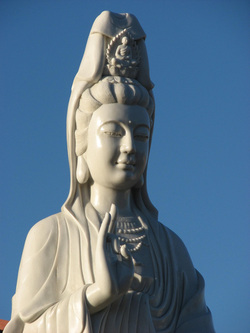KUNDALINI YOGA MEDITATION: MERGER OF THE SUN AND MOON YOGI BHAJAN, APRIL 22, 1977
Tune In with mantra: Ong Namo Guru Dev Namo
When you tune in with the Adi Mantra, you connect with your higher self. This is an ancient Sanskrit mantra and translates the intent, "I bow to my divine consciousness" , "I call upon the creator", "I call upon Divine Wisdom", and "I recognize this higher consciousness in others."
"Ong Namo Guru Dev Namo"
(Chant mantra at least three times.)

POSTURE: Sit in a comfortable meditative posture. Chin in and chest out.
MUDRA: Bring the elbows in to the sides of the body and bring the
hands palm up, fingers together, with the wrists bent back and the fingertips
facing out to each side, parallel with the shoulders. Take care to
maintain the hand position throughout the exercise.
EYES: Tip of the nose; as you continue the meditation, the eyes should
relax and may roll up.
BREATH & MOVEMENT:
Inhale and lift the left hand and shoulder up toward the ear, keeping the
hand bent back and parallel to the floor. As you inhale, you will feel that
the left nostril is more active than the right.
Exhale through the left nostril and lower the hand, returning to the
original position. Repeat on opposite side.
Inhale and lift the right hand and shoulders up. As you inhale you
will feel that the right nostril is more active.
Exhale through the right nostril and lower the hand, returning to the
original position.
Continue to alternate sides and alternate nostrils, with a steady, evenly
paced breath, not quick and not slow.
(Image Left: REGISTERED TRADEMARK of 3HO Foundation International)
COMMENTS: This movement serves to open the nostril on the same side, so that as you move alternate hands, the breath will also alternate
from side to side.
TIME: 11 minutes. Can be increased with practice and experience.
TO END: Inhale and stretch the arms up, looking through the 10th gate meaning your spiritual aperture of consciousness, your personal portal through which you attain spiritual realization, the "Guru's Gateway." Exhale and relax. When completing a Kundalini Yoga Yoga and/or Meditation set, it is tradition to sing "Long Time Sun" song. Please see www.MeditationInMind.com webpage for Healing Sounds and Songs. You may then chose to finish your meditation session with some personal prayers.
MUDRA: Bring the elbows in to the sides of the body and bring the
hands palm up, fingers together, with the wrists bent back and the fingertips
facing out to each side, parallel with the shoulders. Take care to
maintain the hand position throughout the exercise.
EYES: Tip of the nose; as you continue the meditation, the eyes should
relax and may roll up.
BREATH & MOVEMENT:
Inhale and lift the left hand and shoulder up toward the ear, keeping the
hand bent back and parallel to the floor. As you inhale, you will feel that
the left nostril is more active than the right.
Exhale through the left nostril and lower the hand, returning to the
original position. Repeat on opposite side.
Inhale and lift the right hand and shoulders up. As you inhale you
will feel that the right nostril is more active.
Exhale through the right nostril and lower the hand, returning to the
original position.
Continue to alternate sides and alternate nostrils, with a steady, evenly
paced breath, not quick and not slow.
(Image Left: REGISTERED TRADEMARK of 3HO Foundation International)
COMMENTS: This movement serves to open the nostril on the same side, so that as you move alternate hands, the breath will also alternate
from side to side.
TIME: 11 minutes. Can be increased with practice and experience.
TO END: Inhale and stretch the arms up, looking through the 10th gate meaning your spiritual aperture of consciousness, your personal portal through which you attain spiritual realization, the "Guru's Gateway." Exhale and relax. When completing a Kundalini Yoga Yoga and/or Meditation set, it is tradition to sing "Long Time Sun" song. Please see www.MeditationInMind.com webpage for Healing Sounds and Songs. You may then chose to finish your meditation session with some personal prayers.
What is a Mantra? What is a Mudra?

Man·tra /ˈmantrə/Noun
Mudra
1. Indic Hindu religion a "mudra" (Sanskrit, literally "seal") is a symbolic gesture made with the hand or fingers. Along with asanas (postures), they are utilized in yoga meditation practice. Each mudra has a specific meaning, and are a central part of Hindu and Buddhist iconography.
2. Indian music
3. An example would be the outward-facing open palm known as Abhay (without fear) mudra, a gesture meant to dispel the fear of the devotee.
Pictured (Left) is the Goddess of Compassion, Gyan Yin.
- Hindu, Buddhist origin, a sound or word to facilitate concentration in meditation.
- A frequently repeated word, phrase, or statement of intention; a symbolic refrain.
Mudra
1. Indic Hindu religion a "mudra" (Sanskrit, literally "seal") is a symbolic gesture made with the hand or fingers. Along with asanas (postures), they are utilized in yoga meditation practice. Each mudra has a specific meaning, and are a central part of Hindu and Buddhist iconography.
2. Indian music
3. An example would be the outward-facing open palm known as Abhay (without fear) mudra, a gesture meant to dispel the fear of the devotee.
Pictured (Left) is the Goddess of Compassion, Gyan Yin.